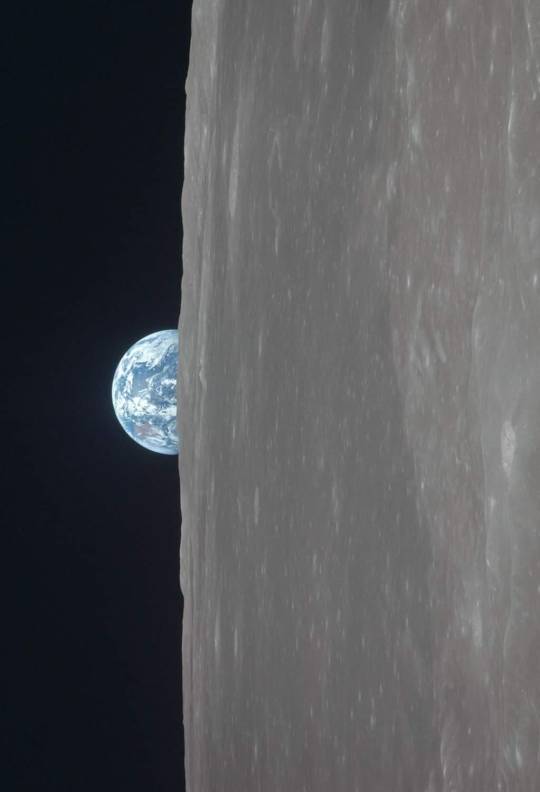#Apollo11
Text

(20 July 1969) Astronaut Edwin E. Aldrin Jr., lunar module pilot of the first lunar landing mission, poses for a photograph beside the deployed United States flag during Apollo 11 extravehicular activity on the lunar surface.
Credit: NASA
590 notes
·
View notes
Text

Preparing for assembly. The Command Service Module of Apollo 11 is hoisted in preparation for connection with the Saturn V rocket, April 1969. The other CSM on the trailer is for the Apollo 12 mission later that year.
#astronauts#nasa#space travel#space exploration#astronaut#apollo11#spacecraft#space age#space race#1969#vintage space#apollo 11#nasa photos#space history#apollo program#project apollo
30 notes
·
View notes
Text
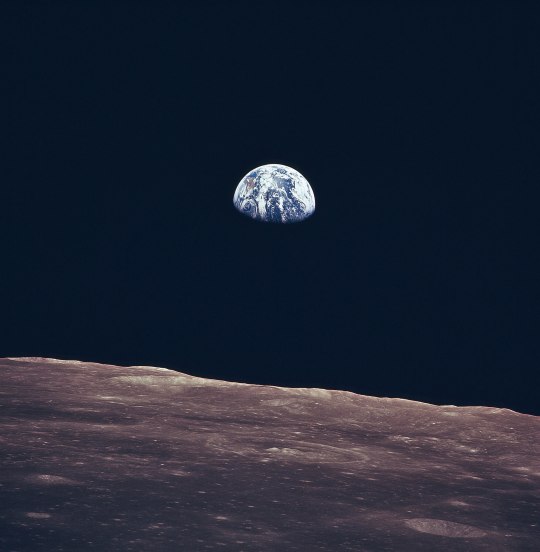
Esta incrível imagem da ascensão da Terra foi tirada durante a órbita lunar pela tripulação da missão Apollo 11 em julho de 1969. A primeira missão lunar tripulada, a Apollo 11, foi lançada a bordo de um veículo de lançamento Saturn V do Centro Espacial Kennedy, Flórida, em 16 de julho de 1969 e retornou com segurança à Terra em 24 de julho de 1969. A tripulação de 3 homens a bordo do voo consistia em Neil A. Armstrong, comandante; Michael Collins, piloto do Módulo de Comando; e Edwin E. Aldrin Jr., piloto do Módulo Lunar.
#astronomy#view#planets#cosmos#earth#apollo11#missionapollo11#earthplanet#earthrise#Exoplanetas#exoplanets#exoplanet#exoplaneta
11 notes
·
View notes
Photo

Meet Apollo 11 Astronauts, the first humans to ever reach the moon and unlock the door to interplanetary trips to another celestial body. When they arrive on the lunar orbit, Michael Collin piloted the orbiter around the moon while Neil Armstrong and Buzz Aldrin descended to the lunar surface aboard the moon lander vehicle. A few seconds to this touchdown, the system began to malfunction and Neil Armstrong used his years of experience as a pilot to manually took control of the vehicle and landed it safely on the Sea of Tranquility region of the moon. You can learn more about Neil Armstrong life experience and his role throughout the Apollo 11 mission from here.
52 notes
·
View notes
Photo
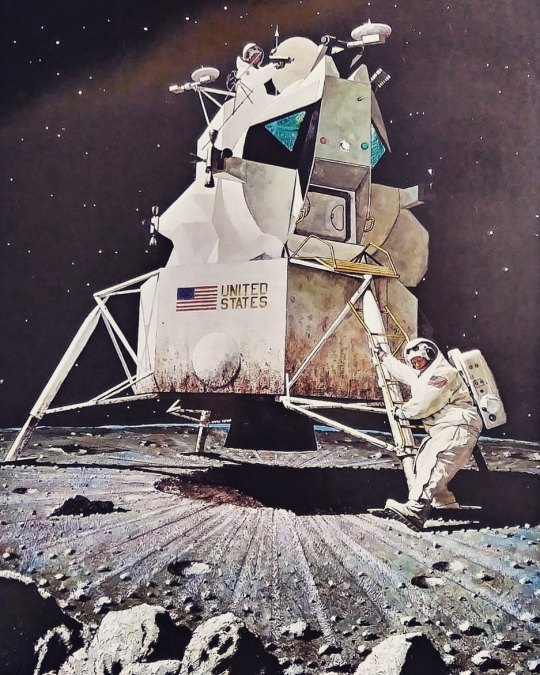
A #normanrockwell #lunarmodule on the #moon 🌙 #space #spaceart #astronomy #astronomyart #spacecraft #spaceexploration #astronaut #nasa #apollo11 https://www.instagram.com/p/CpSS2ZNuoeJ/?igshid=NGJjMDIxMWI=
#normanrockwell#lunarmodule#moon#space#spaceart#astronomy#astronomyart#spacecraft#spaceexploration#astronaut#nasa#apollo11
11 notes
·
View notes
Text
History of Man Going to the Moon: Best Achievement or Best Lie?

Human civilisation has always tried to control itself in the face of weakness in the sky. During the space race and the exploration of the Milky Way, we searched, "Why didn't man go to the moon again?"
In 1969, American mass media guru Neil Armstrong became the first man on the Moon on the Point Luna mission. This achievement brought about a fundamental change in the history of human civilisation.
In recent times, Google, SpaceX, Blue Origin, Elon Musk's SpaceX, and others have announced mass new space missions. Read More...
#searchengine#apollo11#apollo11moonmission#neilarmstrong#প্রথমবারচাঁদেরমাটিতেপারাখাইতিহাস#nasa#space#TruthofApolloMoonMissioninBangla#TheApollo11MoonLandingMystery#youtube#bangladesh#সার্চইঞ্জিন#tumbir#video#foryou
2 notes
·
View notes
Text




1960s/70s and today.
3 notes
·
View notes
Photo
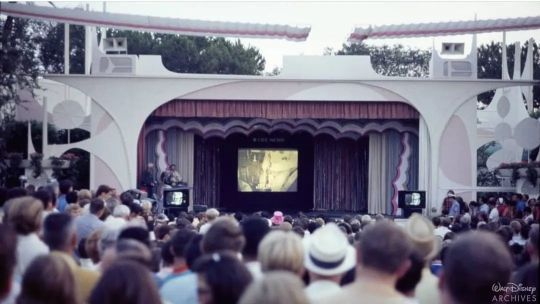
53 years ago today, on July 20, 1969, Disneyland presented on the Tomorrowland stage the live televised Apollo 11 moon landing for park guests to watch the historic moment. #moonlanding #apollo11 #vintagedisneyland #50years #disneyland #onesmallstep #neilarmstrong #lunarlanding #lunarmodule #futureworld #tomorrowland #buzzaldrin (at Disneyland) https://www.instagram.com/p/CgP-CLVPJUa/?igshid=NGJjMDIxMWI=
#moonlanding#apollo11#vintagedisneyland#50years#disneyland#onesmallstep#neilarmstrong#lunarlanding#lunarmodule#futureworld#tomorrowland#buzzaldrin
9 notes
·
View notes
Text
Omega Speedmaster: Storia del Moonwatch

Omega Speedmaster Ref. 310.30.42.50.01.001
Sono stati progettati molti orologi, alcuni hanno avuto successo, altri sono stati apprezzati per la loro bellezza o accuratezza, altri invece, hanno scritto la storia. Oggi, noi di Florense Watch Club, vi parliamo di un orologio intramontabile: l’Omega Speedmaster Professional; o se preferite, The Moonwatch.
L'Omega Speedmaster Professional è un orologio sportivo da polso a carica manuale, che fu prodotto a partire dal 1957 dalla maison di orologi svizzera Omega. È divenuto celebre per essere stato l'unico orologio da polso a superare i severi test effettuati dalla NASA, che necessitava di fornire agli astronauti del programma spaziale Apollo un cronografo affidabile. Così l'Omega Speedmaster cal.321 Ref. ST105.012-65 indossato da Buzz Aldrin divenne il primo orologio a segnare il tempo sulla Luna e gli venne attribuito cosí il titolo di “Moonwatch”.

L’astronauta Buzz Aldrin con il nuovo Speedmaster
La storia dello Omega Speedmaster inizia nel 1943 quando Omega lancia il movimento "27 CHRO C12" dove CHRO sta per Cronografo, 27 il diametro in millimetri, e C12 per il contatore delle 12 ore. Il movimento è disegnato da Albert Piguet. Dal 1946 è disponibile con un sistema antiurto ed un bilanciere amagnetico. Il movimento viene battezzato "321", è montato in diversi tipi di cassa. La cassa dello Speedmaster viene disegnata negli anni cinquanta da Claude Baillod, con inizio della commercializzazione nel 1957 con referenza CK2915-1.
Programma Gemini e i test NASA
Nel 1962, la NASA decide di equipaggiare gli astronauti del suo futuro programma Gemini con un cronografo da polso estremamente accurato, leggibile, resistente e affidabile. Donald K. Slayton, capo delle operazioni di equipaggio in volo, selezionò una serie di cronografi. Ai fini del test di confronto, la NASA acquistò diversi marchi celebri: Elgin, Benrus, Hamilton, Mido, Piccard, Omega, Bulova, Rolex, Longines e Gruen. Di questi, solo 3 sono stati selezionati per le prove di valutazione comparativa: Longines, Omega e Rolex (movimento Omega: Omega 321, movimento Rolex: Valjoux 72, movimento Longines: Longines 13 ZN). I test studiati dalla NASA consistevano in una serie di prove molto dure a cui ogni orologio doveva essere sottoposto per aver il riconoscimento flight qualified by nasa for all manned space mission. Di questi, l’unico ad aver superato egregiamente tutti i severi test Nasa fu l’Omega 321.
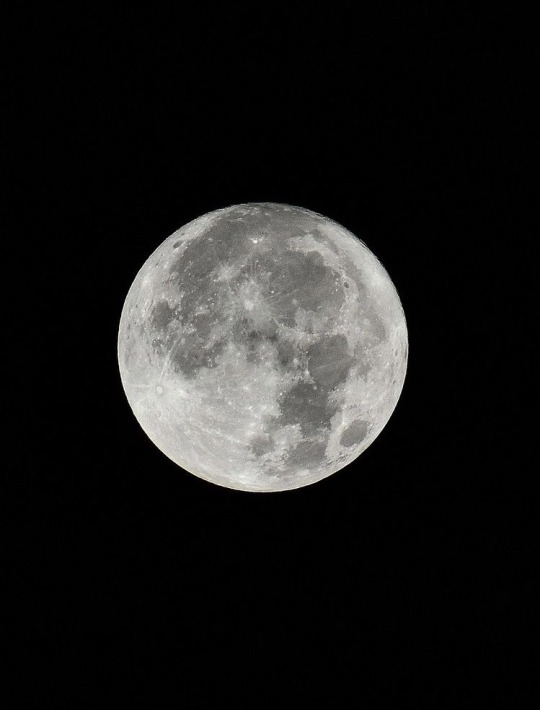
Luna piena scattata con fotocamera D3400, Alaska, USA
L’uomo e la luna: Missione Apollo 11
Il momento più memorabile della storia dello Speedmaster fu l 20 luglio 1969 alle 02:56 GMT quando, dopo Neil Armstrong (che aveva lasciato il suo Speedmaster a bordo della navicella a seguito della rottura del cronografo di bordo) Buzz Aldrin sbarca sulla Luna, portando con sé l'Omega Speedmaster in dotazione. La missione Apollo 11 rappresenta una svolta storica, e lo Speedmaster diventa il primo orologio ad essere andato sulla Luna. Questa impresa memorabile gli vale un soprannome altrettanto memorabile: Moonwatch, l'orologio della Luna.
ENGLISH
Omega Speedmaster: History of the Moonwatch
Many watches have been designed, some have been successful, some have been appreciated for their beauty or accuracy, and some have written history. Today, we at Florense Watch Club, tell you about a timeless watch: the Omega Speedmaster Professional; or if you prefer, The Moonwatch.
The Omega Speedmaster Professional is a hand-wound sports wristwatch, which was produced from 1957 by the Swiss watchmaker Omega. It became famous for being the only wristwatch to pass the stringent tests carried out by NASA, which needed to provide the astronauts of the Apollo space programme with a reliable chronograph. Thus, the Omega Speedmaster cal.321 Ref. ST105.012-65 worn by Buzz Aldrin became the first watch to mark time on the Moon and was thus awarded the title "Moonwatch".
The story of the Omega Speedmaster began in 1943 when Omega launched the "27 CHRO C12" movement where CHRO stands for Chronograph, 27 the diameter in millimetres, and C12 for the 12-hour counter. The movement is designed by Albert Piguet. Since 1946, it has been available with a shock-resistant system and a non-magnetic balance. The movement is christened the '321' and is fitted in different case types. The case of the Speedmaster was designed in the 1950s by Claude Baillod, with marketing starting in 1957 with reference CK2915-1.
Gemini programme and NASA tests
In 1962, NASA decided to equip the astronauts of its future Gemini programme with an extremely accurate, readable, durable and reliable wrist chronograph. Donald K. Slayton, head of flight crew operations, selected a series of chronographs. For the comparison test, NASA purchased several famous brands: Elgin, Benrus, Hamilton, Mido, Piccard, Omega, Bulova, Rolex, Longines and Gruen. Of these, only three were selected for the comparison tests: Longines, Omega and Rolex (Omega movement: Omega 321, Rolex movement: Valjoux 72, Longines movement: Longines 13 ZN). The tests studied by NASA consisted of a series of very tough tests that each watch had to undergo in order to be flight qualified by nasa for all manned space missions. Of these, the only one to have successfully passed all the tests was the Omega 321.
Man and the moon: Apollo 11
The most memorable moment in the Speedmaster's history was on 20 July 1969 at 02:56 GMT when, after Neil Armstrong (who had left his Speedmaster on board the spacecraft following the failure of the on-board chronograph) Buzz Aldrin landed on the Moon, taking his Omega Speedmaster with him. The Apollo 11 mission was a historic turning point, and the Speedmaster became the first watch to go to the Moon. This memorable feat earned it an equally memorable nickname: Moonwatch.
Sources: Omegawatches.com, Wikipedia.it, Pinterest.com
#florensewatchclub#Omega#omegaspeedmaster#speedmaster#moonwatch#Moon#Apollo11#watch#watches#jewerly#jewels
3 notes
·
View notes
Photo

Smoking an Edger Hoill Everyday Hustle cigar and sipping some Eagle Rare this fine whiskey Wednesday. .... On this day, July 20, 1969, the Apollo 11 Lunar Lander "Eagle" with Commander Neil Armstrong and Lunar Pilot Buzz Aldrin aboard touched down at the Sea of Tranquility marking the first time the human race slipped the bonds of Earth, and stepped foot on the Moon. It was a the fulfillment of a promise made by President John F. Kennedy in 1962 and an achievement just 66 years after the first powered flight by the Wright Brothers at Kitty Hawk, NC. In the spirit of exploration displayed by the early days of NASA, the Mercury, Gemini, and Apollo programs, and especially Neil Armstrong, Buzz Aldrin, and Michael Collins I raise a glass tonight, 53 years after men from the planet Earth first stepped foot on the Moon in peace for all mankind. .... "What was most significant about the lunar voyage was not that men set foot on the moon but that they set eye on the earth." ~ Norman Cousins .... #apollo11 #onthisday #thisdayinhistory #cigar #CigarLover #CigarAfficionado #cigarphoto #cigarsnob #cigarlife #cigarsmoke #edgerhoill #cigarsandwhiskey #sailorandsticks #TapThatAsh #whiskey #bourbon #eaglerare #whiskeylife #WhiskeyLover #whiskeyphoto #WhiskeyNeat #WhiskeyAfficionado #whiskeygram #whiskeyandhistory #whiskeywednesday #quote #quotestagram (at Coastal San Pedro) https://www.instagram.com/p/CgQkevbrIDW/?igshid=NGJjMDIxMWI=
#apollo11#onthisday#thisdayinhistory#cigar#cigarlover#cigarafficionado#cigarphoto#cigarsnob#cigarlife#cigarsmoke#edgerhoill#cigarsandwhiskey#sailorandsticks#tapthatash#whiskey#bourbon#eaglerare#whiskeylife#whiskeylover#whiskeyphoto#whiskeyneat#whiskeyafficionado#whiskeygram#whiskeyandhistory#whiskeywednesday#quote#quotestagram
3 notes
·
View notes
Video
youtube
Imagine Dragons - On Top Of The World (Official Music Video)
This video was supposed to be straightforward – it became anything but. After some very detailed research, this was my conclusion. United States History.
(And I believe what I wrote is what occurred [without a doubt])
#youtube#apollo11#buzz aldrin#neil armstrong#cold war#john f kennedy#space race#nasa#moon#moon landing#1969
0 notes
Text

Taking a break. Neil Armstrong & Buzz Aldrin take a load of their feet during training for their historic Apollo 11 mission, Jan 1969. During his career, Mr. Armstrong spent 8 days & 14 hours in space on his Gemini 8 & A11 missions. Mr. Aldrin logged just shy of 12 days & 2 hours on Gemini 12 & A11. 2 historic figures in space exploration & #1 & 2 on the moon respectively.
#astronauts#nasa#space travel#space exploration#astronaut#vintage space#space race#space age#moon landing#space#neil armstrong#buzz aldrin#1969#apollo11#project apollo#nasa astronauts#space program#space history#1960s#apollo program#space suits#spacesuit#apollo 11
12 notes
·
View notes
Link
#2001:ASpaceOdyssey#2001:OdysseeimWeltraum#Apollo11#EdwinAldrin#Hasselblad#Hasselblad500ELDataCamera#HasselbladKamera#MichaelCollins#Mondlandung#MoonLanding#NeilArmstrong#Originalaufnahmen#StanleyKubrick
0 notes
Link
What's the first word that comes to mind seeing this?
#drawing#ghostmoon#ghostlymoon#fullmoon#alienmoon#outerspace#moon#magicmoon#magicalmoon#mooncraft#witchcraft#apollo11#apollo13#artemis#spacemission#beautifulmoon#bluemoon
0 notes
Photo

#Apollo11 #Astronauts #NeilArmstrong & #BuzzAldrin during one of many #training sims for their famous #eva on the #moon to come! 🌝 #moonlanding #nasa #spacecraft #lunarmodule #spacehistory #astronauttraining #spaceexploration #nasa #apolloprogram https://www.instagram.com/p/Co0mT-BOS31/?igshid=NGJjMDIxMWI=
#apollo11#astronauts#neilarmstrong#buzzaldrin#training#eva#moon#moonlanding#nasa#spacecraft#lunarmodule#spacehistory#astronauttraining#spaceexploration#apolloprogram
19 notes
·
View notes
